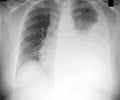Kollam district tuberculosis (TB) Centre decided to test every residing inmate of agathi mandiram with the aim of decreasing and eliminating the number of TB cases.

‘Using 'active case-finding' strategy, the state has planned to test every citizen for tuberculosis and map vulnerable communities so as to routinely monitor, test and treat them.’
Read More..




For the first time this year, the center sent a pulmonologist to examine every person in the home, as part of the Kerala TB Elimination Mission launched in March 2018 with the aim of reducing the number of TB cases to 2020 by the year 2020, and eliminating TB-related deaths altogether. Read More..
"It was challenging because the inmates often could not explain their symptoms nor give their sputum sample," said P. Anish, a consultant chest physician who screened all the inmates. Deploying techniques not normally used to detect TB, such as the CT-Scan, he detected 22 cases.
This exercise was replicated across the state from April to June in an effort to screen every person in Kerala, after the state set its sights on eliminating TB, displaying confidence in its robust health system which has already delivered enviable indicators.
This confidence is why, for Kerala, eliminating TB is "low-hanging fruit," as the state's Health Secretary, Rajeev Sadanandan, puts it. "We are about the only state [that] is capable of eliminating this disease," he told IndiaSpend.
Kerala's strategy has implications for all of India, which has the world's largest TB burden of 2.74 million or 27 percent of the global total. Further, nearly 300,000 Indians fall through the surveillance system or do not complete their course of medication, prompting the rise of more virulent, drug-resistant strains. In 2016, 435,000 people in the country died of TB. Patients often incur financial distress due to catastrophic health expenses.
Advertisement
"The reduction of TB cases in Kerala is dramatic," said K.P. Aravindan, a retired professor from Kozhikode Medical College. "From a disease that was extremely common, it is now a rare disease."
Advertisement
Active case-finding involves health workers proactively screening people for TB, as opposed to people coming to health institutions with TB-like symptoms and getting screened, which has been the mainstay of the Revised National Tuberculosis Control Programme (RNTCP) for more than 15 years.
The Central TB Division, which works under the central health ministry and is responsible for implementing RNTCP, requires all state TB units to conduct an active case-finding exercise thrice a year among populations identified as vulnerable, such as those living in slums and labor camps, mine workers, tea garden workers and the homeless. This is typically done in an ad-hoc fashion, and there is no consistent follow-up, mostly because the number of TB cases is high and resources are stretched thin.
Kerala, however, has improved an already robust healthcare system and a motivated workforce to implement active case-finding so thoroughly that each resident will be screened this year, with health workers going door-to-door to find cases. The persons identified as vulnerable will be followed-up every three months.
These activities have increased the number of symptomatic patients tested per 100,000 from about 700 close to the all-India figure to nearly 1,250, according to the Kerala State TB Cell.
TB affects mostly young adults the world over. In Kerala, however, proportionally more people over 45 years have TB, data collected by the State TB Cell show. Between 2004 and 2014, the proportion of TB cases among those above 45 years increased by more than 10 percent.
This suggested a link between chronic diseases such as diabetes, which affect older people more, and TB.
This led to a change in policy first within the state starting 2012 and since 2017 across India so that TB patients are as a rule tested for diabetes and vice-versa. Following Kerala's example, all TB patients registered under RNTCP are supposed to be referred for screening for diabetes. Referral is the responsibility of the health institution where TB treatment is initiated.
In addition to increased surveillance, the state has deployed more diagnostic tools such as the Cartridge-based Nucleic Acid Amplification Test (that can detect TB bacilli in very small amounts of sputum), X-Ray and CT-scan during active case-finding, as at agathi mandiram in Kollam.
"We have reached a saturation point in detecting TB using sputum microscopy," said Kumar, referring to the technique in which the laboratory technician looks for TB bacilli in sputum a mixture of saliva and mucus a subject has coughed up using a microscope. "It is now time to use other techniques."
Complementary programmes underway in some other districts engage with treatment support groups and with the private sector to increase reporting of cases (private-sector cases are typically under-reported so that official TB statistics reflect mostly incidence, prevalence, treatment and cure figures reported by the public sector). From January to July 25, 2018, there have been 2,672 notifications from the private sector and 10,200 from the public sector, Balakrishnan said.
Across India, about 20 percent of the total reported cases were in the private sector, while in Kerala, the figure was 36 percent.
For two decades now, children living with infected adults have been given preventive drugs and are monitored as part of a protocol called chemoprophylaxis. Now, the state has decided to give infection-control kits to TB-positive patients, said Kumar, consisting of masks, disposable spittoons and disinfectant solution to protect TB from spreading to family members.
The department has found just 352 new cases of TB all over the state in a population of 38 million during the active case-finding and vulnerability mapping exercise so far, Balakrishnan said.
Kerala's TB incidence is estimated to be 67 cases per 100,000, less than half the 138 per 100,000 pan-India. Since 2009, when Kerala began active case-finding, the TB notification rate in the state's public sector has been falling by about three percent every year. This is even though the number of people being tested for TB has remained constant, Balakrishnan said.
The proportion of TB in children under 15 years has consistently fallen in Kerala. In 2016, 6.3 percent of TB cases were among children (under 14 years), down from 8.7 percent in 2008.
Fewer children are being affected because the primary transmission has gone down, state TB officer Sunil Kumar told IndiaSpend. This could mean that direct transmission of the disease from the environment or other TB patients has reduced.
The biggest lesson Kerala holds for the rest of the country lies in the basic implementation of the programme -- treating the TB patient who comes to the hospital appropriately, said Yogesh Jain, a founder member of Jan Swasthya Sahyog, a community hospital in Bilaspur.
The importance of following the "old-fashioned" guidelines from RNTCP related to early diagnosis, completion of treatment and other protocols cannot be overstated. "There are no magic bullets here. Kerala is showing a mirror to the rest of the country that we have to do what we are supposed to do well," he said.
While Kerala's example may not be entirely replicable across India given the vast population, the paucity of resources and lack of infrastructure, capability, and preparedness much can be done with the existing resources too.
Aravindan pointed out that even in low-resource states such as Odisha and Chhattisgarh, some programmes work. "It is political will that makes programmes work," said Aravindan.
(In an arrangement with IndiaSpend.org, a data-driven, non-profit, public interest journalism platform. Menaka Rao is an independent journalist based in Delhi. The views expressed are those of IndiaSpend. Feedback at [email protected])
Source-IANS















